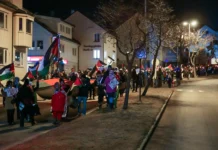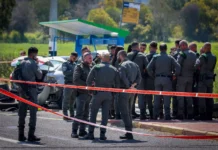At the end of March, Maj.-Gen. Tamir Heiman, who had been head of the IDF National Defense College since 2015, became the IDF’s new head of the Military Intelligence Directorate. He follows Maj.-Gen. Herzi Halevi, who completed a three-and-a-half-year term that was full of dramatic challenges and achievements.
Heiman is taking the helm at a critical moment in Israel’s low-profile campaign to disrupt the force buildup of its enemies, a campaign dubbed “the War Between the Wars.”
This campaign, which has been going on for several years, is a central IDF effort that affects resources, doctrine, and planning.
The campaign has made headlines in recent months as Israel has enforced its red lines against Iran’s aggressive and threatening military expansion into Syria. The campaign has also included many steps to challenge the trafficking of advanced weaponry to Hezbollah’s bases in Lebanon. It seems safe to assume that Hamas’s attempts to build up its ability to attack Israel have also run into Israel’s War Between the Wars.
Sooner or later, the campaign to thwart the enemy’s force buildup is bound to trigger threats of retaliation from those targeted. Yet the Israeli defense establishment has, so far, been able to apply a mixture of deterrence, diplomacy, and signaling to dissuade enemy decision makers, particularly those in Tehran and Beirut, from taking action that can spin out of control.
The Military Intelligence Directorate is at the heart of this campaign and its many achievements. It is likely that most of those achievements remain utterly unknown to the general public.
Speeches delivered during Heiman’s entrance ceremony contain hints about the huge scope of work that remains to be done in this area.
IDF Chief of Staff Lt.-Gen. Gadi Eisenkot noted that recent years have brought large-scale regional changes, and pointed out that members of the Iranian axis are exploiting these changes to build up their capabilities against Israel. Those actors range from Iran itself, which “continues to try and consolidate its grip on Syria, through to the attempts by the Hezbollah organization to arm itself,” Eisenkot said.
“Every operational success of the Israel Defense Forces, every powerful fire strike activated by our fighters – is a result of your quiet work,” he said, addressing Military Intelligence. “It is a product of quality intelligence information, an alert delivered with the required speed, and a knowledge of the enemy and its patterns.” The improved capabilities and achievements of Military Intelligence on Halevi’s watch dramatically increased the security of Israeli citizens, Eisenkot said.
Halevi will now become commander of the IDF’s Southern Command, where he will manage the defense establishment’s attempt to prevent Gaza from boiling over into conflict, and oversee war preparations in case those efforts at conflict prevention fail.
Halevi, in his own remarks, said Military Intelligences operates “day and night” in the War Between the Wars. He spelled out the complex dilemmas and guiding principles behind this large-scale campaign. Challenges include determining whether an operation should be initiated, how and when an operation should be conducted, and how to respond to an enemy operation “in a way that achieves deterrence but does not escalate, so that it will serve the interests in the State of Israel in the short term as much as it does in the long term.”
Listing the components that enabled success thus far, Halevi mentioned a major Israeli investment in attaining “information supremacy,” a highly developed cyber capability, and a partnership between Military Intelligence, the IDF’s C4i Corps (which runs computing, communications, and command and control networks), and the air force.
Unprecedented quantities of accurate, speedy intelligence have become available as a result, making the War Between the Wars possible.
Incoming Military Intelligence chief Heiman acknowledged that “many challenges” await him and his personnel. As he takes up his position, Iran is threatening retribution against a missile strike on the T4 airbase in the central Syrian Desert, which reportedly killed several IRGC personnel, including the head of the organization’s drone program.
The defense establishment prefers to keep the War Between the Wars at a low intensity. Israel seems prepared to continue to grant its enemies a sphere of deniability of the attacks so they can avoid pressure to escalate.
At the same time, if Iran and its partners insist on escalating, they stand to lose most of their military assets in Syria and beyond. This was made clear by the reported release of intelligence data in April listing airfields in Syria used by the IRGC.
The dilemma, then, returns to Iran. It must choose between a) trying to complete its takeover of Syria and the rest of the region; or b) responding to the War Between the Wars in a way that turns it into a high-intensity conflict with Israel. Choosing the latter would likely put Iran’s entire Syrian and Lebanese projects, as well as the Iranian homeland itself, into firing range. The idea that the Israeli home front would absorb heavy fire while Iran’s core assets remain unscathed is not likely to be accepted by Israel in the event of a significant future armed conflict.
Yaakov Lappin is a Research Associate at the Begin-Sadat Center for Strategic Studies and is JNS’s Military Correspondent. BESA Center Perspectives Papers are published through the generosity of the Greg Rosshandler Family.

























